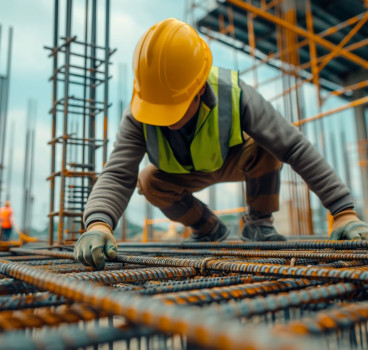Why Steel is Sustainable - and what this means for the future
It can be difficult to look to the future with a sense of optimism at times. Anxieties over our ever-burgeoning global population, with its increasing thirst for finite natural resources, always seem to be just a headline away. But in-between all of the doom and gloom are remarkable success stories. The sustainable prowess of the steel industry is one of them.
For starters, steel is one of the few materials in the modern world that is encapsulated in a truly closed recycling loop. It can be used again and again. Whereas other highly recyclable products tend to degenerate or diminish over time, steel can actually be enhanced in quality and strength. This is known as ‘upcycling'. This fact alone may explain why steel is the most recycled material in the world.
It might be more appropriate to say that steel is not ‘consumed' like almost everything else. Rather, it is just ‘used'.
Steel hegemony
Steel is everywhere in our building, planning, and construction thanks to its reusability, but also because it is manufactured from one of the most abundant elements on Earth – Iron and Carbon. Iron ore is mined in around 50 countries, but Australia, Brazil, and China are the largest producers. The overwhelming majority of iron ore is extracted for steel-making (98 per cent).
Steel has a high tensile strength and low cost, with a malleability and strength-to-weight ratio that goes a long way and invites creativity and ingenuity among the world's planners and architects.
Steel is thought to have been in production as early as 4,000 years ago in modern-day Spain and the Roman military are understood to have used a form of Celtic (Noric) steel for weaponry. Steel is still used for weaponry in the twenty-first century, but it is also used to support – both literally and metaphorically – modern-day economies. China's economic growth invigorated a huge thirst for steel, and the British Geological Survey has estimated China to be the top steel producer today, churning out about one-third of the total global output.
The United Kingdom is one of the world's leaders in steel construction (although it only accounts for 0.7 per cent of world production, this puts it in the top ten), yet it has shown remarkable leadership in so-called ‘circular economy' of steel. Current levels of recovery rates from demolition sites stands at 99 per cent for structural steel work and 96 per cent for steel based products. This is in comparison to a global recycling rate of about 60 per cent.
The steel industry in the United Kingdom has an output of around £1.6 billion, approximately 0.1 per cent of the economy. It employs a similar percentage of the available workforce, with most of them being located in Wales, and Yorkshire and the Humber.
Steel Adaptability
The steel frames that make up building structures can be thought of as a kit of parts. This means they can easily dismantled and repurposed. Because so many connections are bolted in place, these bolts can simply be removed, in prime condition, and entire structures can almost always be used for some other purpose without much reconfiguring. In some cases buildings can be dismantled, and their steel structures repurposed in a matter of months. This relatively minimal deconstruction and construction can take place with minimal dust, dirt, and noise pollution.
Because steel can span large distances, this means that most steel buildings have large open-plan spaces. That is why airplane hangers, warehouses, areas, stadiums and agricultural buildings all tend to be made entirely out of steel. These open-plan spaces can easily be reused – often as lightweight partition walls. Steel frames can always have parts added or taken away to accommodate extra floors without overloading the existing foundations. Existing steel buildings can also be modified relatively easily. Changes, such as the addition of new lift spaces or stairways, or the raising or lowering of ceilings for more column spaces, are much easier to make with the flexibility of steel. Creating shallower floor depths can also help minimize heating and cooling costs in the long run.
Steel is not just adaptable, but durable. It is non-combustible and highly resistant to fire. It is also virtually invulnerable to structural damage posed by insect infestation or water. Steel can be primed or galvanized to shield it from rust and rot. It doesn't settle, warp, swell, or twist, either. Steel structures have been built (in their respective areas) to withstand high winds, heavy snow, and even earthquakes.
The future of steel
The future continues to look positive for sustainable steel. Energy consumption and carbon dioxide emissions from European steelmaking have already made considerable progress over the past 50 years – achieving reductions of up to 60 per cent. But target reductions are always being implemented to further drive down these emissions. The Ultra-Low CO2 Steelmaking Partnership (ULCOS) has set goals of reducing CO2 emissions of steel production by half by the middle of the century – an ever important goal if the ‘tipping point' of runaway climate change is to be avoided.
The steel industry has already met and exceeded its carbon emissions reduction targets set out by the 1992 Kyoto Protocol by an astonishing 240 per cent. The Environmental Protection Agency has awarded it a “best industry performance” designation. At the same time steel is manufactured at strength 40 per cent greater than it was just 25 years ago, while using much less energy. Over 22 billion tonnes of steel are estimated to have been recycled worldwide since the beginning of the twentieth century.
If only the other major industries of the world could encapsulate the success of the steel industry over the last 50 years. If it were possible for similar success stories to dominate most of the world's important industries, then thinking about the future would no longer be met with troubled thoughts, but with a warm smile.
Check out the below Infographic for more feel-good facts about steel.

--
This article was provided by Weldwide, an organization of architectural and structural metal workers based in London.
Additional Blogs

What the UK can learn from global construction tech leaders
The UK construction sector stands at a critical crossroads. Mounting pressures - stagnant productivity, acute labour shortages, tightening safety requirements, ambitious carbon-reduction targets and...
Read moreAre architects losing their influence in the digital era?
For decades, architects have been the central creative force in construction, shaping the buildings we see and the way projects are conceived, communicated and delivered. Their role has been...
Read more

Why the word “Innovation” has lost its meaning in construction
“Innovation” has become one of the most overused terms in construction. It appears in the dozens of press releases we receive each day, conference talks and project reports, often without any real...
Read more